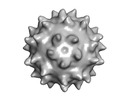[English] 日本語
 Yorodumi
Yorodumi- EMDB-3303: Cryo-EM reconstruction of Seneca VAlley Virus - receptor complex -
+ Open data
Open data
- Basic information
Basic information
| Entry | Database: EMDB / ID: EMD-3303 | |||||||||
|---|---|---|---|---|---|---|---|---|---|---|
| Title | Cryo-EM reconstruction of Seneca VAlley Virus - receptor complex | |||||||||
 Map data Map data | Cryo-EM reconstruction of SVV-receptor complex | |||||||||
 Sample Sample |
| |||||||||
| Biological species |  Seneca valley virus Seneca valley virus | |||||||||
| Method | single particle reconstruction / cryo EM / Resolution: 18.0 Å | |||||||||
 Authors Authors | Miles LA / Burga L / Bostina M / Poirier JT / Rudin CM | |||||||||
 Citation Citation |  Journal: J Clin Invest / Year: 2017 Journal: J Clin Invest / Year: 2017Title: Anthrax toxin receptor 1 is the cellular receptor for Seneca Valley virus. Authors: Linde A Miles / Laura N Burga / Eric E Gardner / Mihnea Bostina / John T Poirier / Charles M Rudin /   Abstract: Seneca Valley virus (SVV) is an oncolytic picornavirus with selective tropism for neuroendocrine cancers. It has shown promise as a cancer therapeutic in preclinical studies and early-phase clinical ...Seneca Valley virus (SVV) is an oncolytic picornavirus with selective tropism for neuroendocrine cancers. It has shown promise as a cancer therapeutic in preclinical studies and early-phase clinical trials. Here, we have identified anthrax toxin receptor 1 (ANTXR1) as the receptor for SVV using genome-wide loss-of-function screens. ANTXR1 is necessary for permissivity in vitro and in vivo. However, robust SVV replication requires an additional innate immune defect. We found that SVV interacts directly and specifically with ANTXR1, that this interaction is required for SVV binding to permissive cells, and that ANTXR1 expression is necessary and sufficient for infection in cell lines with decreased expression of antiviral IFN genes at baseline. Finally, we identified the region of the SVV capsid that is responsible for receptor recognition using cryoelectron microscopy of the SVV-ANTXR1-Fc complex. These studies identify ANTXR1, a class of receptor that is shared by a mammalian virus and a bacterial toxin, as the cellular receptor for SVV. | |||||||||
| History |
|
- Structure visualization
Structure visualization
| Movie |
 Movie viewer Movie viewer |
|---|---|
| Structure viewer | EM map:  SurfView SurfView Molmil Molmil Jmol/JSmol Jmol/JSmol |
| Supplemental images |
- Downloads & links
Downloads & links
-EMDB archive
| Map data |  emd_3303.map.gz emd_3303.map.gz | 20.2 MB |  EMDB map data format EMDB map data format | |
|---|---|---|---|---|
| Header (meta data) |  emd-3303-v30.xml emd-3303-v30.xml emd-3303.xml emd-3303.xml | 6.9 KB 6.9 KB | Display Display |  EMDB header EMDB header |
| Images |  emd_3303.png emd_3303.png | 203.8 KB | ||
| Archive directory |  http://ftp.pdbj.org/pub/emdb/structures/EMD-3303 http://ftp.pdbj.org/pub/emdb/structures/EMD-3303 ftp://ftp.pdbj.org/pub/emdb/structures/EMD-3303 ftp://ftp.pdbj.org/pub/emdb/structures/EMD-3303 | HTTPS FTP |
-Validation report
| Summary document |  emd_3303_validation.pdf.gz emd_3303_validation.pdf.gz | 215 KB | Display |  EMDB validaton report EMDB validaton report |
|---|---|---|---|---|
| Full document |  emd_3303_full_validation.pdf.gz emd_3303_full_validation.pdf.gz | 214.2 KB | Display | |
| Data in XML |  emd_3303_validation.xml.gz emd_3303_validation.xml.gz | 5.8 KB | Display | |
| Arichive directory |  https://ftp.pdbj.org/pub/emdb/validation_reports/EMD-3303 https://ftp.pdbj.org/pub/emdb/validation_reports/EMD-3303 ftp://ftp.pdbj.org/pub/emdb/validation_reports/EMD-3303 ftp://ftp.pdbj.org/pub/emdb/validation_reports/EMD-3303 | HTTPS FTP |
-Related structure data
| Similar structure data |
|---|
- Links
Links
| EMDB pages |  EMDB (EBI/PDBe) / EMDB (EBI/PDBe) /  EMDataResource EMDataResource |
|---|
- Map
Map
| File |  Download / File: emd_3303.map.gz / Format: CCP4 / Size: 21.7 MB / Type: IMAGE STORED AS FLOATING POINT NUMBER (4 BYTES) Download / File: emd_3303.map.gz / Format: CCP4 / Size: 21.7 MB / Type: IMAGE STORED AS FLOATING POINT NUMBER (4 BYTES) | ||||||||||||||||||||||||||||||||||||||||||||||||||||||||||||
|---|---|---|---|---|---|---|---|---|---|---|---|---|---|---|---|---|---|---|---|---|---|---|---|---|---|---|---|---|---|---|---|---|---|---|---|---|---|---|---|---|---|---|---|---|---|---|---|---|---|---|---|---|---|---|---|---|---|---|---|---|---|
| Annotation | Cryo-EM reconstruction of SVV-receptor complex | ||||||||||||||||||||||||||||||||||||||||||||||||||||||||||||
| Projections & slices | Image control
Images are generated by Spider. | ||||||||||||||||||||||||||||||||||||||||||||||||||||||||||||
| Voxel size | X=Y=Z: 3.12 Å | ||||||||||||||||||||||||||||||||||||||||||||||||||||||||||||
| Density |
| ||||||||||||||||||||||||||||||||||||||||||||||||||||||||||||
| Symmetry | Space group: 1 | ||||||||||||||||||||||||||||||||||||||||||||||||||||||||||||
| Details | EMDB XML:
CCP4 map header:
| ||||||||||||||||||||||||||||||||||||||||||||||||||||||||||||
-Supplemental data
- Sample components
Sample components
-Entire : Cryo-EM reconstruction of Seneca Valley Virus - receptor complex
| Entire | Name: Cryo-EM reconstruction of Seneca Valley Virus - receptor complex |
|---|---|
| Components |
|
-Supramolecule #1000: Cryo-EM reconstruction of Seneca Valley Virus - receptor complex
| Supramolecule | Name: Cryo-EM reconstruction of Seneca Valley Virus - receptor complex type: sample / ID: 1000 / Number unique components: 2 |
|---|
-Supramolecule #1: Seneca valley virus
| Supramolecule | Name: Seneca valley virus / type: virus / ID: 1 / NCBI-ID: 390157 / Sci species name: Seneca valley virus / Virus type: VIRION / Virus isolate: SPECIES / Virus enveloped: No / Virus empty: No |
|---|---|
| Host (natural) | Organism:  Homo sapiens (human) / synonym: VERTEBRATES Homo sapiens (human) / synonym: VERTEBRATES |
-Experimental details
-Structure determination
| Method | cryo EM |
|---|---|
 Processing Processing | single particle reconstruction |
| Aggregation state | particle |
- Sample preparation
Sample preparation
| Vitrification | Cryogen name: ETHANE / Instrument: LEICA KF80 |
|---|
- Electron microscopy
Electron microscopy
| Microscope | JEOL 2200FS |
|---|---|
| Date | Oct 1, 2015 |
| Image recording | Category: CCD / Film or detector model: TVIPS TEMCAM-F416 (4k x 4k) / Number real images: 400 / Average electron dose: 30 e/Å2 |
| Electron beam | Acceleration voltage: 200 kV / Electron source:  FIELD EMISSION GUN FIELD EMISSION GUN |
| Electron optics | Illumination mode: FLOOD BEAM / Imaging mode: BRIGHT FIELD |
| Sample stage | Specimen holder model: JEOL |
- Image processing
Image processing
| Final reconstruction | Applied symmetry - Point group: I (icosahedral) / Resolution.type: BY AUTHOR / Resolution: 18.0 Å / Resolution method: OTHER / Software - Name: Relion / Number images used: 400 |
|---|
 Movie
Movie Controller
Controller









 Z (Sec.)
Z (Sec.) Y (Row.)
Y (Row.) X (Col.)
X (Col.)





















